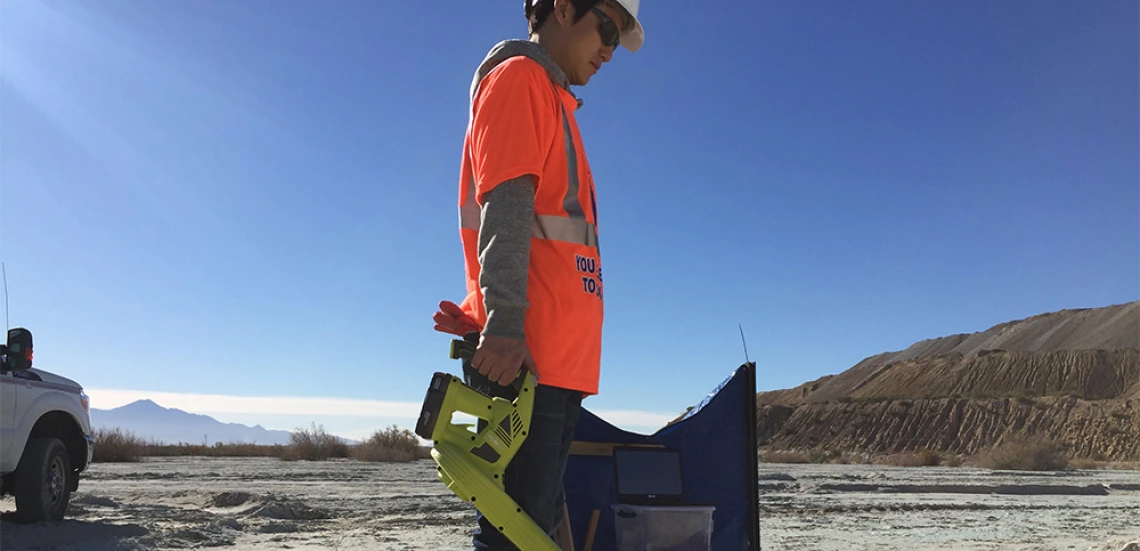Startup Licenses UA-engineered Solutions to Control Dust in a Dry World

TUCSON, Ariz. – Using technology developed at the University of Arizona, startup Clean Earth Tech plans to provide a novel solution to a common problem in arid climates – air pollution caused by dry air and blowing dust.
People living in dry climates worldwide experience the problems wrought by dry air and blowing dust, which affects everything from respiratory health to cars and other machinery. To control dust in areas like mines and construction sites, the general practice is to spray the ground with water. While this method does keep dust levels down, sites require constant reapplication, especially in arid climates like Arizona.
To address the problem, researchers at the UA College of Engineering and the BIO5 Institute have developed an environmentally safe biocompatible polymer blend that, when added to water used for dust control, keeps the ground damp for more than two months, even when exposed to the open desert air. Through Tech Launch Arizona, the UA office that commercializes inventions stemming from research, the university provided funding to advance the invention, protected the intellectual property, and licensed it to startup Clean Earth Tech to bring it to the marketplace.
"Most of my work has been about finding new things and contributing to science,” says inventor Minkyu Kim, assistant professor of materials science and engineering and biomedical engineering. “I’m very excited to know that my work is benefitting all of society, not just academia.”
Doug Hockstad, associate vice president of TLA, sees moving Kim’s work into the public sphere via commercial pathways as the natural next step to create impact from his research.
“It feels like every year we hear more about the negative environmental and economic impact of dust storms, especially in arid climates like southern Arizona. The development and commercialization of Dr. Kim’s work is an important example of the kind of impact researchers at the UA are making,” he says. “We’re excited to have the opportunity to work with him to help get it out into the world.”
The project was an epiphany for Kim, as his research career to this point has been focused on biomaterials, not air pollution.
“I learned that there were a lot of mining companies with air pollution issues,” he says. “I saw this problem of water drying too quickly and thought about using these materials to keep dust wetter longer.”
According to Kim, many companies have been using water along with commercial dust suppressants mostly based on salts or acrylic or vinyl polymers developed before the 2000s. Today, extensive research motivated by the desire to address environmental issues, not just air pollution control, has resulted in more options for materials to apply to the problem – especially materials that are safe to put into groundwater.
“I was surprised that these well-known materials in other research fields were not adapted for dust suppression technology yet,” Kim says. “That’s when I knew I had something special.”
Bob Sleeper, TLA senior licensing manager for the College of Engineering, and TLA Mentor-in-Residence Steve Wood, originally worked with the Kim and Assistant Professor Kwangmin Kim of the Mining and Geological Engineering Department to identify opportunity in dust control applications and develop the Clean Earth Tech startup strategy. Because the material is biocompatible and safe for human consumption, it is not only perfectly suited for use in mining facilities, but could also be ideal for use by cities, counties, and farming communities – any environment where dust control is needed, Sleeper says.
Another attractive feature of the invention is that it can be applied using existing technologies and machinery. The new material can be mixed with water and applied using today’s water tank trucks and spraying techniques.
Kim and Kim awarded funding through TLA’s Asset Development program to do further experimentation needed to prove the material’s utility and effectiveness.
“Many regions – Maricopa County, for example – continuously fail to meet mandated airborne particulate level requirements just because of the dryness and the wind,” Sleeper says. “If there are cities or companies that can take this technology forward, we’ll be looking to work with them.”
To help zero in on the best application for the invention, Kim went through the NSF I-Corps program offered by TLA, a six-week course in customer discovery and lean startup methodology taught by instructors from the McGuire Center for Entrepreneurship and the Eller College of Management. Through the program and his collaboration with program mentors and TLA Commercialization Partners Mark Baker and Alex Schauss, he was able to connect with mining companies Freeport McMoRan and ASARCO, who were interested enough in the technology to provide space for Kim’s field tests. Kim also used the funding provided through the program to travel to Korea and introduce the technology to the City of Seoul and the Korea Electric Power Research Institute.
Based on the lessons and customer discovery work learned through the I-Corps program, Clean Earth Tech will pursue east Asia as a strong potential market. This year in South Korea, the Special Act on Particulate Matter Reduction and Management, which took effect in February, is being enforced to limit the amount of dust industries like coal power plants can emit. If they are caught going over their limit, the industry must lower their emission rates or pay high fines.
“If they don’t get their polluting under control, the worst case is that they risk getting shut down,” he says. “They’re looking for these solutions now.”
Most recently, Clean Earth Tech entered into an agreement with Seoul Metropolitan Subway to field test the product for reducing dust levels in subway tunnels.

